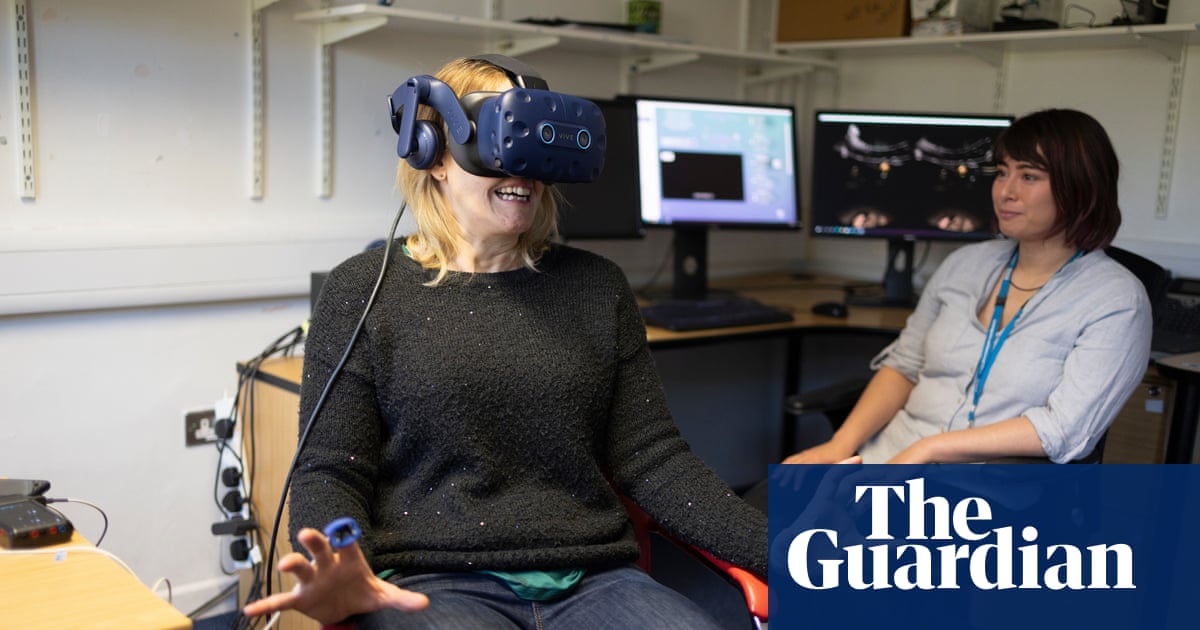
Tethered to a chair, in a gloomy basement, I’m doing my best not to panic – by breathing in for four seconds, holding for seven, and slowly releasing for eight. But when a bloodthirsty monster appears at my feet and starts crawling towards me, I don’t need a dial to tell me that my heart is pounding, and I’m in imminent mortal danger.
Welcome to the future of anxiety treatment: a virtual reality (VR) game that teaches you a breathing technique to help calm your nerves, and then pits you against a monstrous humanoid that wants to eat you, to practise deploying it in genuinely panic-inducing situations.
Developed by researchers at the University of Cambridge, with help from a local video game company, Ninja Theory, the game is being tested as a means of teaching people a strategy to cope with everyday anxiety. For me, this could include filing a story for the Guardian, at extraordinarily short notice, or trying to get out of the door with two children, when I’m already running late.
“We are looking at anxiety as a thing that most people experience, as opposed to a specific anxiety disorder, trying to teach emotion regulation techniques that could be useful to most people at some point in their life,” said Lucie Daniel-Watanabe, a doctoral student who is leading the research.
“Therapists often ask people to learn techniques, such as breathing techniques, in totally static and unengaged ways, and then say: ‘Try this while you’re stressed.’ But there’s no way of getting people to try it when they’re stressed in that therapeutic situation. VR allows you to completely manipulate the environment that people are in, which can be really useful in that regard.”
With the VR headset in place and a heart-rate monitor attached to my finger, I’m transported on to a rowing boat, on a tranquil lake at sunset. A soothing voice encourages me to breathe in, hold my breath, and exhale at the appropriate time points, and as I feel increasingly relaxed and my pulse slows, the boat moves gently forwards.
After about five minutes of this, I’m ready to begin the next stage of my training: the dungeon. Even though I know it’s just a game, the immersive nature of VR helps to suspend my disbelief, and I’m surprised to hear my heartbeat thumping in my ears. In the top corner of my vision, a small dial tells me that my heart is pumping significantly faster than when I was on the boat, which reminds me of what I am here for. I start to slow my breathing, and the dial creeps gradually downwards too – even when I hear a fellow prisoner screaming, and look to my left to see a body being dragged backwards out of sight.
Then, suddenly, the monster is in front of me, emaciated, grey-skinned, and blindfolded with a horrible smile on its mouth. I’ve been told that it can’t see me, but it can use my heartbeat to sense my location; the only way to avoid death is to use the relaxation technique to bring my heart rate down.
I try my best, but the monster is too close, and too horrible. Afterwards – once the monster has jumped on me, and the screen has gone black – Daniel-Watanabe tells me she deliberately put me on a more difficult level, because many of subjects she’s tested it on so far were too good at avoiding death.
Striking the right balance, not to mention validating the approach among larger and more diverse groups of individuals, could take some time. But other VR-based approaches are already being trialled within the NHS, for example to help people who are suffering from social anxiety or agoraphobia to practise everyday scenarios, such as being in the street or inside a shop, under the guidance of a virtual coach.
Partnering with a gaming company could take such experiences to a new level. Gamification of the process may also help motivate people to practise useful techniques, such as breathing exercises, rather than relying on internal motivation – “which, if you’re in a really rough place, might be hard”, Daniel-Watanabe said.
While she would never wish to see VR used in place of therapy, “it might be a resource that people could use if they were on a waiting list for cognitive behavioural therapy, to learn some basic techniques in the interim”, she said.
As for me, while I’d be reluctant to go back into that dungeon, the encounter has reminded me to try slow breathing, when I’m feeling stressed. Even an imminent deadline is no match for that monster.












